It is customary to call human parasites all organisms that live at their expense. These are bacteria, fungi, worms. Human parasites are divided into internal and external. The most unpleasant and most destructive of the body are helminths - various parasitic worms.
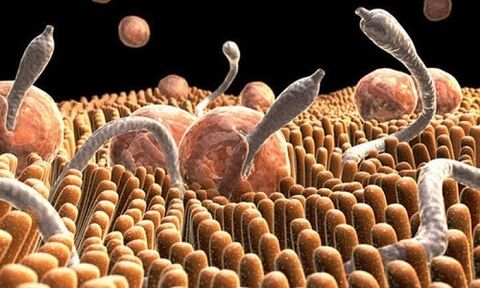
Parasites and the human body
Living things that parasitize the human body can be external or internal. External includes:
- Mosquitoes.
- Leech.
- Lice.
- Microorganisms that cause cholera.
There are more living things that prefer to be inside the body. These include:
- Bacteria.
- The simplest.
- Helminths.
- Mushrooms.
The external and internal organization of the parasite is the simplest. Organizations have been greatly simplified because they do not need development to survive.
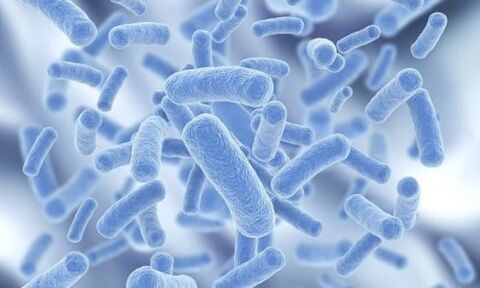
There are many living things that prefer to be located inside the body. For example, there may be bacteria.
They cannot live without a host organism because they cannot get their own food. However, all of them, almost without exception, reproduce very quickly, especially under suitable conditions. Where they are not immediately driven.
They differ geographically. Some can be found everywhere, no climate is an obstacle for them. Others live only in tropical countries, but can be easily transmitted to others in the human body. They are also located in different places on the body.
Luminal parasites are satisfied with empty parts of the body, and those that are in the tissue live in the tissues.
The developmental stages of parasites, especially helminths, are also different. Some grow first in the soil (biohelminths) and then migrate to living things. Others must first develop in the body of any living being, but not a human being. Others who are already adults can be transferred to another person or re-infected.
It is a mistake to think that infection can only occur through dirty hands. The eggs of some helminths live outside the food environment for six months and adhere well to animal hair. Eggs also live in a dangerous environment for them - if you cook meat or fish incorrectly, you can get a whole worm's palate inside.

The meat is worth cooking incorrectly, because it can contain a whole worm's palate.
Human endoparasites
Parasites are divided into endoparasites and ectoparasites. Endoparasites - inside, ecto - outside. Endoparasites can be found in almost all internal organs and tissues of the body. They are divided depending on the location. Endoparasites are:
- Endoparasites of internal organs associated with the external environment.
They are located entirely in the organs associated with the external environment, not vice versa: the parasitic organism does not prefer to "breathe". These organs include the intestines, lungs, and the human urinary system. These are amoebae, worms and parasitic flagella.
- Blood parasites.
They live in human blood. They can live in plasma, white blood cells, erythrocytes. These are trypanosomes, microfilaria or hemosporidia.
- Tissue endoparasites.
Endoparasites that choose the tissues of the body as their habitat. Muscle tissue, brain, cartilage, connective tissue. Such tissue may contain endoparasites in nerve fibers. These are Finnish tapeworms, trypanosomes, myxosporidia, trichina and others.
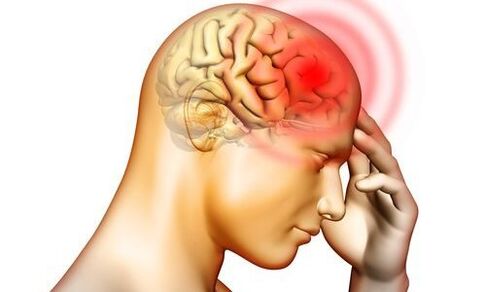
Endoparasites can choose the brain as a habitat.
The definition of the type of parasite by location is quite arbitrary. Many species can migrate through various internal organs and regularly pass through the body of the host. The process of reproduction can take place in one place, and organisms will exist and feed directly elsewhere. The location and conditional localization of the parasitic entity will be considered.
Despite the simplification of many parasitic systems, their life cycle is quite complex.
Some species have to change several owners during their lifetime, which may belong to different biological species. Others may only survive in one species, but may need medium-sized owners. In one they multiply, in another they develop and mature. With such a complex life cycle, sexual functions increase significantly. In order to survive in the body, parasites must multiply rapidly and multiply.
Helminths
There are three main types of helminths, also called worms. O:
- Nematodes, they are roundworms.
- Cestodes, ribbon-shaped endoparasites.
- Trematodes, also known as flukes.

Geohelminths begin to exist on earth.
In addition, they can be divided according to the length of their life cycle and the number of places they travel along the way. There are three types:
Geohelminths
"Geo" is the place. These worms begin to exist on earth, and can only be transmitted to humans after they have matured. No need for intermediate owners; enters the soil together with egg feces. They develop only in the warm season until the larval stage.
Such worms include roundworms, intestinal snakes, nekator, and whipworms.
The larvae of these parasites can enter the human body through direct contact with unwashed vegetables or soil.
Biohelminths
These are parasitic worms whose life stages pass through several houses. Depending on the type of worm, there may be two or more intermediate mothers. Some parasites change only one person. Others use the organisms of other biological beings to develop before they finally enter the human body.

In addition to contact with pets or other people, you can be infected by eating semi-raw meat. Biohelminths include bovine worms, echinococcus, tapeworm, trichina and others.
Infectious worms
These worms do not need soil or intermediates. They go through all the stages of their life cycle in an organism that is in a very comfortable state. Larvae are excreted directly from the human body and spread freely when in contact with household surfaces and other people.
Helminths can live in various organs and systems of the human body, migrating from one part of the body to another from time to time.
The list of diseases caused by helminths is very extensive. It is possible to determine which parasites live in the body and which treatment will be started only after passing all the tests necessary to determine the type of tests.
Roundworms
Roundworms, also known as nematodes, are the most common in the human environment. In total, there are more than 24, 000 species of nematodes in the world.
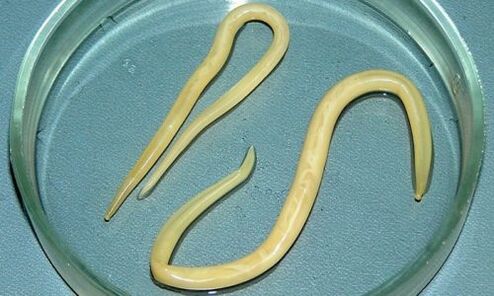
The most common human nematodes are roundworms.
They are called round according to the shapes that appear when you make a section. The most common human nematodes:
- Ascaris.
- Pinworms.
- Trichina.
- Vlasoglava.
The spread of helminths, known as ascariasis, begins with direct contact with worm-infested soil or by eating unwashed fruits and vegetables. Parasites begin to develop in the intestines, then enter the human circulatory system, from where they travel to various internal organs and into the oral cavity. Without realizing it, a person re-absorbs an already mature parasite. They feed on the remains of undigested food. Ascaris waste is extremely toxic. There is no vaccine for ascariasis; infection is prevented only by following the rules of personal hygiene.
Pinworm infection is called enterobiasis. These are small worms (5-10 mm) that attach to the intestinal wall. They feed on blood and intestinal contents. They lay their eggs under the skin and leave the anus while the owner is sleeping. Due to itching, a person scratches the anal area, the larvae get under the skin and on the hands, and can easily infect people at home or in public. There are no painful symptoms of enterobiasis, and early detection of pinworm infection is extremely problematic.
Trichinella, also known as Trichinella, are roundworms that choose an animal or one as their owner.
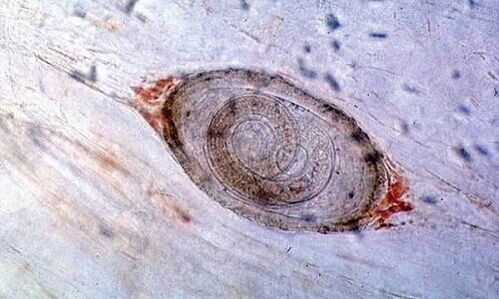
Trichinella is a parasitic worm that infects the human body and causes the dangerous helminthic disease trichinosis.
The striated muscles in the body begin to develop in the area, and then are directed to the small intestine. In advanced infections, one kilogram of muscle tissue can contain about 15, 000 Trichina eggs. The source of these parasites can cause a deadly disease called - trichinosis.
Whipworms are so named because of their appearance. The front of their small bodies is like a thread, with an esophagus inside.
The back is wider, the rest of the parasite's internal organs are inside it. The length of the whipworm can be up to 50 mm. It feeds on blood and tissue fluids. Trichocephalosis causes the disease.
Black worms
There are about 3, 500 species of tapeworms in the world called cestodes. These flatworms generally have no digestive system, and the diseases they cause are called cestodes.
The most common cestodes:
Cysticercosis
The disease is caused by the larvae of the tapeworm, which enters the contaminated food from dirty hands.
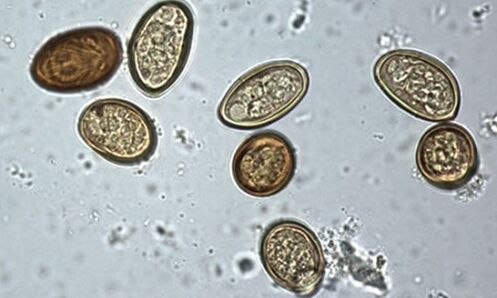
The disease affects the skin, bones, internal organs, brain and spinal cord. Parasites are often transmitted to the brain (60% of infections). Diagnosis is based on the appearance of round formations on the skin. The disease is treated; In case of infection of the central nervous system, the prognosis may be unfavorable.
Echinococcosis
Localized in the liver, lungs and many other internal organs. Echinococcus larvae excite the disease. They can develop in a person for several years.
Infection occurs through contact with animals, collecting berries and fruits, and drinking contaminated water.
The course of the disease is not very noticeable, it can develop over the years, and it turns out that it is detected only by chance.
Alveococcosis
Alveococcosis is caused by the larvae of alveococcus worms. The disease is similar to echinococcosis, but more severe. Affects the lungs and kidneys. Without treatment, the disease is more likely to be fatal due to the development of liver failure.

Alveococcosis most often affects the kidneys.
Teniarinhoz
Teniarinhoza is caused by a bovine tapeworm. Parasitizes tapeworms in the human small intestine, develops in 2, 5-4 months. The prognosis for treatment is often favorable. Parasites can enter a person with infected raw or sufficiently thermally processed meat.
Tapeworms are very productive. The rest have the least reduced sensitivity and generally no digestive system. Such parasites cannot grow without a host.
Worms
There are flukes flukes. These are flat worms that look like the elongated leaves of a tree.
Some trematode species can be up to one and a half meters.
And most are in the human body with fish or other seafood. There are about 7, 200 known strains of influenza, 40 of which live in humans and cause trematodes, a serious disease caused by infection.
The most common confusions:
Hepatic hemorrhage
Distributed globally, it can be present in animals and humans. The biological life cycle is complex, with parasites changing hosts.
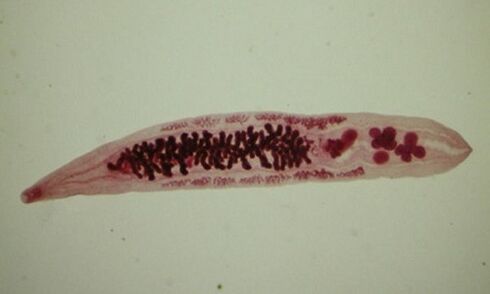
The most common is liver cirrhosis.
Schistosome
Schistosomiasis larvae can penetrate the skin or mucous membranes. Life cycle is complicated, they feed on blood. A female can produce about 3, 000 eggs a day, and the productivity of these parasitic worms is very high.
Other liver flukes
They mainly cause opisthorchiasis, a helminthic disease that spreads to the liver. They are toxic to the human body.
The digestive system of red worms is well developed, as well as the reproductive and excretory systems.
The remaining systems are poorly developed. Trematodes feed on blood, skin epithelial cells and intestinal contents. They can live almost anywhere: from the liver to the conjunctival sacs of the eyes.
Other types of endoparasites
The rest of the internal parasites are various bacteria that cause dangerous diseases, and with them the simplest microorganisms. Fungi that spread in the human body also belong to the endoparasite.
Many beneficial and harmful microorganisms live in the human body. Some cause very dangerous diseases that can be fatal. It is not always possible to immediately recognize the presence of parasitic organisms within oneself, but early diagnosis of infection provides a better chance of complete cure. If an invasion is suspected, a thorough examination by a physician is recommended immediately.




































